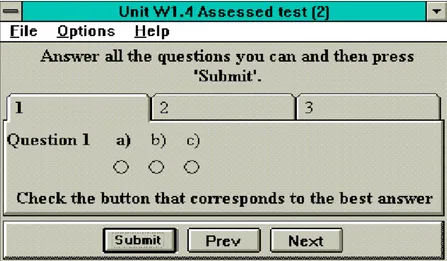Using SToMP for Teaching in a Small Group
Richard A Bacon
CTI Centre for Physics, University of Surrey, UK
The SToMP project has been funded largely by the Higher Education Funding Councils of England, Wales and Scotland, and by the Department of Education for Northern Ireland. Substantial contributions have also been made by Queensland University of Technology, Australia and the University of Guelph, Ontario, Canada.
Introduction
The SToMP project (Software Teaching of Modular Physics) has created computer based teaching and learning materials for topics in physics, with a pedagogic style that is based upon distance learning principles. The material has been produced by a collaboration between staff from several different universities, and includes many interactive models, scripts, pictures, diagrams, a glossary, biographies, text book sections, problems, self and assessed tests as well as a set of software tools for data analysis and display.
This case study concerns the use of SToMP materials as part of the formal delivery of a first year acoustics specialist course during the 1997/8 session in the Physics Department at the University of Surrey, UK. This was the third year in which SToMP had been used in this way, but it was the first time that the assessed tests had been used to provide any part of the formal assessment of the course.
The class, and logistics
The University of Surrey Physics Department's Degree in Physics with Modern Acoustics, has two specialist lecture courses during the first year, one being called "Introduction to Acoustics". This includes topics such as quality factor of a resonant system, the wave equation, energy and power of a wave and musical instruments, etc. that are covered in some detail within SToMP, as well as other topics that were not.
The course comprises 40 hours of contact time. Half of this is spent in lectures and half in the computing laboratory. This specialist course has had up to 15 students in some years, but in 1997 had only eight.
Study practices
The first session started with a 10 minute introduction as to how the SToMP system worked, what features it offered, and how these features could be used. The first unit within each SToMP module is designed as an introduction to using the package, and students were strongly advised to start by working through this unit. In practice, all the students were more or less Windows proficient before starting to use SToMP, and no serious difficulties were encountered.
The recommended SToMP practice when it is used within an academic institution is that academic demonstrators (staff or postgraduates) are present during timetabled sessions to help with academic problems. In the case of this small class, I was present during all sessions and found the opportunity of talking individually with the students very helpful both in getting to know them better and in improving my understanding of their individual difficulties with the topics.
Experiences
As usual when a self-learning tool is provided for students in place of some lectures, there is a strong negative reaction from some students, based upon the idea that teaching is something that we (the academics) do to them (the students). When the advantages of using such a system (such as the flexibility of learning speed and the close integration of interactive examples with the theory) became clearer, the antagonistic reaction shown by some almost completely disappeared.
Some students also found difficulty at a technological level (e.g. with the size of the text on a monitor, or with sound not being available) without realising that such things were simple to adjust or correct.
For most students, two hours use of the system was sufficient for them to become familiar with the main features. More advanced features were introduced by encouraging the students to revisit the introductory units in weeks three or four.
Student assessment
The SToMP system has the facility for self tests and an assessed test to be provided within each unit, although in practice not all units are equipped with them yet.
Figure 2. Assessed test answer box
Figure 3. Automatic marking of test questions
Conclusion
The system proved to be very convenient. Some of the units selected were for revision, and with these units it was only necessary for the students to show they were able to answer the questions. With all units tested, the tests themselves provided sufficient motivation for the students to work through all the material (in contrast to previous years where the tests were not used).
I found that the inclusion of the assessed tests made a significant difference from previous years in two ways: firstly the attendance was better, particularly towards the end of the course, and secondly I found that I had a much better idea of how they were progressing. It appeared that the threat of an end-of-course examination was not felt as keenly as a number of end-of-unit tests. The actual results of the tests were not particularly significant, but clearly the doing of them made a difference to the students' appreciation of the course material and thus ensured the whole component was taken more seriously.
Richard A Bacon CTI Centre for Physics University of Surrey Guildford
Surrey GU2 5XH United Kingdom r.bacon@surrey.ac.uk

